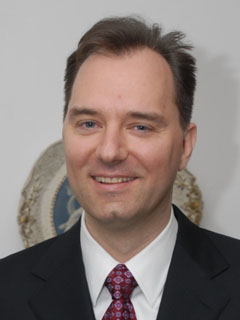New Professor - Dejan Kostic
Dejan Kostic is a new professor in Internetworking at KTH School of Information and Communication Technology since first of April. In this interview he tells us about himself and his research area.
Welcome to KTH School of Information and Communicaton Technology! Can you tell us a bit about yourself?
– Originally, I am from Belgrade, Serbia where I attended a Math and Science-specialized High School. There I had excellent teachers that strengthened my love of science and helped shape my future interests. I got my Bachelor’s degree at a School that is very similar in spirit to KTH School of Information adn Communication Technology, so I feel right at home here. Being appointed as a Professor of Internetworking is a great honor for me and a dream come true. I still get excited like a child when I write code that transmits a message from one network node to another, despite having seen this happen so many times. Photography is a hobby that excites me, and it helps me with both teaching and research. For example composing elements in a picture is as exciting as deciding on the composition of a presentation slide, or choosing an effective way of conveying experimental data.

Tell us about your research area.
– I love building distributed systems that pay close attention to the conditions in the underlying network. These so-called networked systems form the foundation of our society's infrastructure. Complex distributed protocols and algorithms are used in enterprise storage systems, distributed databases, large-scale planetary systems, and the Internet itself. Errors in these systems translate to denial of service to some clients, potential loss of data, and monetary losses. It is difficult to develop reliable high-performance networked systems, and yet this is an area that I am passionate about. For about three years I have been working on an exciting new area called Software-Defined Networking (SDN). SDN hold great promise for making it easier to deploy new network protocols, simplify network management, and reduce cost. However with the introduction of programmability in the network, the potential for catastrophic network failures errors due to programming bugs is only going to increase dramatically. Today, data and computation is increasingly being moved toward the logically centralized "cloud". One of the appealing features of the cloud is being able to only pay for the resources one needs. A number of difficult issues arise in this environment, for example knowing exactly how many resources to request from the cloud provider at any given point in time (given that the workload is changing), and dealing with performance interference in the virtualized cloud environment.
An exciting new research area is the so-called Carrier Cloud, and has the potential to give carriers a competitive advantage. In this type of a cloud, the carriers can provide performance guarantees by using their network to interconnect geo-distributed cloud datacenters that also belong to them.
What will your contribution be to KTH?
– I am passionate about teaching and I look forward to being able to inspire students to work in the general area of ICT as well as my subject domain. Research-wise, my expertise stems from the following two primary visions in my research group. The first vision is to leverage increases in computational power and bandwidth to make networked systems more reliable and easier to develop. For example, we demonstrated a networked system’s ability to proactively predict inconsistencies that can occur in a running system due to unknown programming errors and effectively prevent them. The second vision is to build networked systems that mimic the energy-proportionality of biological systems. For example, we produced Energy-Centric Networks that can overcome the power delivery and cooling limits that the Internet is starting to encounter. I am excited to be bringing my European Research Council (ERC) Starting Grant to KTH. In this project, my goal is to dramatically change the way distributed systems are developed and deployed. Among other contributions, my group has created tools for testing SDN applications (running at OpenFlow controllers in particular), and network switches that support OpenFlow.
What have you done before coming to KTH?
– After obtaining my Bachelor of Science degree in Computer Engineering and Information Technology from the University of Belgrade (ETF) in Serbia I went to the US (University of Texas at Dallas) where I received my Master of Science degree in Computer Science. I worked more than four years as a software engineer in two startups before going back to graduate school. I had the pleasure of obtaining my Ph.D. in Computer Science at Duke University, and I spent the last two years of my doctoral studies at the University of California, San Diego.
After graduating with my PhD, I worked as a tenure-track Assistant Professor at Ecole Polytechnique Fédérale de Lausanne (EPFL) in Switzerland. During my stay there I completed two research projects funded by the Swiss NSF and graduated two PhD students. Before joining KTH, I worked for slightly over a year at IMDEA Networks Institute (Madrid, Spain) as a Research Associate Professor with tenure.
Why did you choose a position at KTH?
– Being a highly-ranked University, KTH will allow me to pursue the right combination of teaching and research. Also, I was impressed with the faculty members and the overall vision for the University. Moreover, the unique Kista campus is the perfect environment for technology transfers to the local well-known companies. Top quality of life in Sweden also played a role for convincing my family to relocate to Stockholm.

